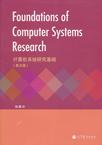计算机系统研究基础
出版时间:2010-10 出版社:高等教育出版社 作者:施巍松 编 页数:267
Tag标签:无
前言
The field of computer systems is the core of computer science, and is concerned with how todesign and implement a "good" system that is able to satisfy a variety of requirements and needsfrom end users and applications. The definition of "good" depends on to whom we are talking,and it could" mean one or several of these basic requirements, to name a few: reliability, scalability,availability, usability, adaptability, agility, dependability, and performability. We envision that moreand more new requirements will emerge as computing becomes more and more transparent andembedded in our daily life. This unstoppable trend, however, brings great challenge to futurecomputer systems designers and practitioners. There is a gap between what the students learnedin the classroom and what they are going to build in the real world. The goal of this book is topresent the fundamental knowledge and techniques by laying out the foundations for the studentswho want to become researchers in the general area of computer systems. The book is intended forboth senior undergraduate students and junior graduate students in the fields of computer scienceand computer engineering. Practitioners and systems designers in industry and research laboratorieswill find the book a very useful reference. One important principle guiding the writing of this bookis that it should contain the material I would want my own students to learn before beginning theirresearch. The focus of systems research has changed considerably since the inception of computers. How-ever, we have witnessed that several fundamental techniques and principles have been frequentlyused in systems research in the last fifty years. The goal of this book is to provide beginning com-puter systems researchers enough background for undertaking further systems research in theircareer path. The philosophy of this book is foundation, in other words, only the techniques thatwill at least survive for more than 10 years are selected.
内容概要
自从计算机问世以来,计算机系统结构的研究重点发生了很多变化,这让一些希望从事这方面研究的新手觉得很难入门。作者根据多年从事研究和指导研究生的经验,把计算机系统研究中最常用的原理和关键技术汇集在一起。在基本知识部分,作者描述了从事系统结构研究的基本要领,包括如何读、写、说,以及英文写作最常见的问题,并给出了12个最经典的设计原理和经验。在关键技术部分,作者从建模、设计、实现和性能评测方面选择了15个关键技术进行了详细的讨论和描述,每一个关键技术的题目都经过精心挑选,并且提供多个实例分析。《计算机系统研究基础(英文版)》可供计算机系统结构初学者使用,也可供高年级本科生和研究生在学习有关课程时参考。
作者简介
施巍松,美国韦恩州立大学计算机科学系副教授,移动和因特网系统结构实验室主任,可持续计算实验室主任。美国国家科学基金会杰出青年教授奖获得者,全国百篇优秀博士论文获得者。IEEE资深会员,IEEE Internet Computing及Joumal of Parallel and Distriibuted Computinq客座编辑,Journal of Computer Scierice and Techology及International Journal of Sensor Networks编委。施巍松博士的研究兴趣包括计算机系统和可持续计算等。
书籍目录
Part I General 1 Elements 1.1 Top Systems Conferences/Journals 1.2 How to Read a Research Paper 1.3 How to Write a Research Paper 1.4 How to Give a Presentation 1.5 Final Words: On Being a Scientist References 2 Rules of Thumb 2.1 Rules of Thumb 2.2 Further Readings ReferencesPart Ⅱ Design 3 Bloom Filters 3.1 Introduction 3.2 Standard Bloom Filters 3.3 Counting Bloom Filters 3.4 Compressed Bloom Filters 3.5 D-left Counting Bloom Filters 3.6 Spectral Bloom Filters 3.7 Dynamic Counting Bloom Filters 3.8 Case Studies 3.8.1 Case Study 1: Summary Cache 3.8.2 Case Study 2: IP Traceback 3.9 Conclusion. References 4 Distributed Hash Tables 4.1 Introduction 4.2 An Overview of DHT 4.3 The Overlay Network of DHT 4.4 Chord: An Implementation of DHT. 4.5 Case Study 1: Cooperative Domain Name System (CoDoNS) 4.6 Case Study 2: Cooperative File System (CFS) References 5 Locality Sensitive Hashin 5.1 5.2 Overview. 5.3 Case Study 1: Large-Scale Sequence Comparison 5.4 Case Study 2: Image Retrieval References 7 Adaptation 8 Optimistic Replication. 9 Reputation and Trust 10 Moving AveragePart Ⅲ ImplementationPart Ⅳ Evalution
图书封面
图书标签Tags
无
评论、评分、阅读与下载
用户评论 (总计2条)
- 未来的导师推荐的一本书 ,赞一个。不错
- 希望尽快出中文版
